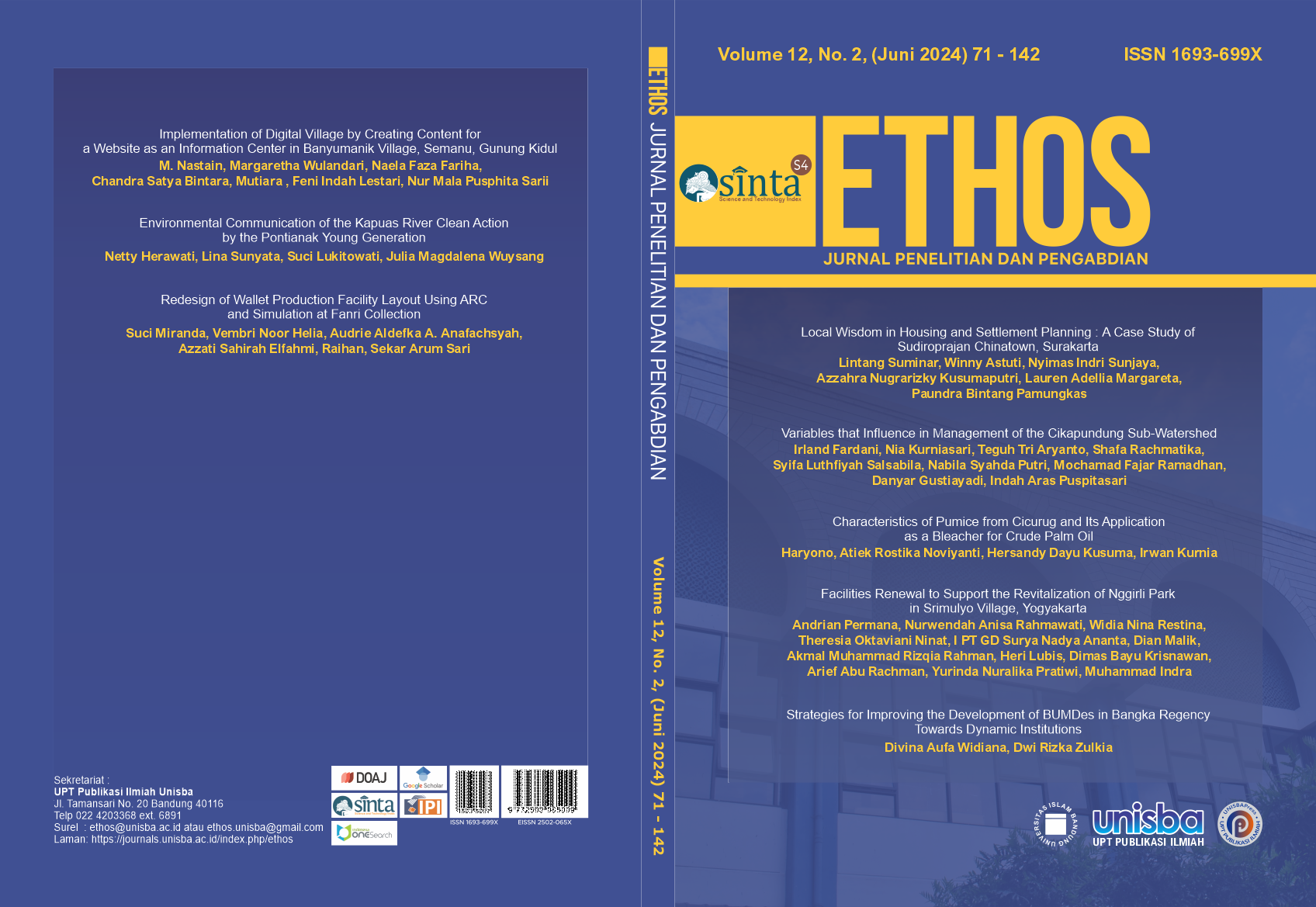Characteristics of Pumice from Cicurug and Its Application as a Bleacher for Crude Palm Oil
DOI:
https://doi.org/10.29313/ethos.v12i2.3537Keywords:
bleaching, crude palm oil, pumiceAbstract
Pumice is relatively abundant in Indonesia, especially in Cicurug District, Sukabumi. Pumice has unique characteristics, so it has the potential to be an alternative bleaching agent or a bleacher for crude palm oil. Bleaching is one of the stages in processing crude palm oil into palm cooking oil. In the cooking oil industry, the bleaching of crude palm oil generally uses bentonite as a bleacher. This research aims to determine the characteristics of pumice and the optimum conditions for the bleaching process of crude palm oil with pumice as a bleacher. The research method consists of pumice activation, activated pumice characterization, degumming of crude palm oil, bleaching of crude palm oil, and analysis of processed palm oil. The results show that the metal oxide composition in activated pumice is dominated by silica (62.99%) and alumina (14.79%) and has a non-uniform pore size distribution. Optimum bleaching conditions are achieved when using 30% pumice and a bleaching temperature of 105 oC for 30 minutes. Under optimal bleaching conditions, pumice can reduce the color brightness level of crude palm oil from 600 to 125 mg/L Pt, or a bleaching power of 79.2%.
References
Adiarso, Ismariny, Mahmud, J., Prihawantoro, S.: Editor. 2019. Outlook Teknologi Pangan 2019: Teknologi Industri Pangan Berbasis Minyak Sawit. Pusat Pengkajian Industri Proses dan dan Energi, Badan Pengkajian dan Penerapan Teknologi (BPPT), Tangerang.
Aleksandrova, T., Nikolaeva, N., Afanasova, A., Romashev, A., Kuznetsov, V. (2023). Justification for Criteria for Evaluating Activation and Destruction Processes of Complex Ores. Minerals, Vol. 13, No. 5: 684. https://doi.org/10.3390/min13050684
Aldakshe, A., Caglar, H., Caglar, A., Avan, C. (2020). The Investigation of Use as Aggregate in Lightweight Concrete Production of Boron Wastes. Civil Engineering Journal, Vol. 6, No. 7: 1328–1335.
Anis, U., Millati, R., Hidayat, C. (2022). Optimization of Crude Palm (Elaeis guineensis) Oil Bleaching using Zeolite-Fe by Response Surface Methodology. Agritech, Vol. 42, No. 1: 23–29. http://doi.org/10.22146/agritech.48114
AOAC, Association of Official Analytical Chemists. (1994). Official Methods of Analysis of The Association of Official Analytical Chemists. AOAC Inc., Washington D.C.
Asgari, G., Rahmani, A.R. (2012). Preparation of an Adsorbent from Pumice Stone and Its Adsorption Potential for Removal of Toxic Recalcitrant Contaminants. Journal of Research in Health Sciences, Vol. 13, No. 1: 53–57.
Astuti, W., Amin, M., Aprimal. (2006). Pemucatan Minyak Sawit dengan Cara Adsorpsi Menggunakan Zeolit Alam Lampung. Jurnal Zeolit Indonesia, Vol. 5, No. 2: 85–88.
BPLG, Badan Pusat Lingkungan Geologi. (2009). Penuntun Praktikum Kimia Fisik Geologi. Departemen Energi dan Sumber Daya Mineral Republik Indonesia. Bandung.
Ersoy, B., Sariisik, A., Dikmen, S., Sariisik, G. (2010). Characterization of Acidic Pumice and Determination of Its Electrokinetic Properties in Water. Powder Technology, Vol. 197: 129–135.
Haryono, Ali, M., Wahyuni. (2012). Proses Pemucatan Minyak Sawit Mentah dengan Arang Aktif. Berkala Ilmiah Teknik Kimia, Vol. 1, No. 1: 7–12.
Hasanah, F., Anwar, S., Hartono, A., Sudadi, U. (2019). Potential Use of Alkaline-Activated Indonesian Pumice Powder as Lead Adsorbent in Solution System. Journal of Soil Science and Agroclimatology, Vol. 16, No. 2: 203–215.
Meyyappan, P..L., Sutharsan, R., AhamedAzik Ali, M. (2019). Experiment Investigation on the Effect of Silica Fume and Pumice Stone in Developing Light Weight Concrete. Material Science and Engineering, Vol. 561 (012064): 1–6. doi:10.1088/1757-899X/561/1/012064
Mourhly, A., Khachani, M., El Hamidi, A., Kacimi, M., Halim, M., Arsalane, S. (2015). The Synthesis and Characterization of Low-cost Mesoporous Silica SiO2 from Local Pumice Rock. Nanomaterials & Nanotechnology, Vol. 5, No. 35: 1–7.
Muralitharan, R.S., Ramasamy, V. (2015). Basic Properties of Pumice Aggregate. International Journal of Earth Sciences & Engineering, Vol. 8, No. 4: 256–263.
Ojewumi, M.E., Ezeocha, C.R., Alagbe, E.E., Obanla, O.R., Omodara, O.J. (2021a). Optimization of Bleaching of Crude Palm Oil Using Activated Groundnut Hull. IOP Conf. Series: Materials Science and Engineering, Vol. 1107, No. 012142: 1–10. https://doi:10.1088/1757-899X/1107/1/012142
Ojewumi, M.E., Ehinmowo, A.B., Obanla, O.R., Durodola, B.M., Ezeocha, C.R. (2021b). Comparative Analysis on the Bleaching of Crude Palm Oil Using Activated Groundnut Hull, Snail Shell, and Rice Husk. Heliyon, Vol. 7 e07747. https://doi.org/10.1016/j.heliyon.2021.e07747
Oktariadi, O., Kasbani, Memed, W.M. (2021). Environmental Geology of the Bandung Basin. Geological Agency Publisher, Ministry of Energy and Mineral Resources, Bandung (Available in Indonesian).
Pahan, I. (2008). Panduan Lengkap Kelapa Sawit. Edisi 5. Penerbit Penebar Swadaya. Jakarta
Radhi, I.K., Hussein, M.A., Kadhim, Z.N. (2019). Factors Affecting the Adsorption of Some Ionic Dyes on the Surface of Modify CaO from Eggshell. Asian Journal of Applied Sciences, Vol. 7, Issue 01: 63–70.
Rosana, M.F., Widhiyatna, D., Kartawa, W. (2024). West Java Mineral Resources Potential: Towards Sustainable West Java Development: 1–13. Unpad Publisher. Available in Indonesian at https://pustaka.unpad.ac.id/archives/127462 (accessed 8 March 2024).
SNI 7709-2019: Standar Nasional Indonesia Minyak Goreng Sawit.
Usman, M.A., Oribayo, Adebayo, A.A. (2013). Bleaching of Palm Oil by Activated Local Bentonite and Kaolin Clay from Afashio-EdoNigeria. Chemical and Process Engineering Research, Vol. 10: 1–12.
Wahyuni, S.E., Wulandari S. (2020). Utilization of Used Cooking Oil from Refined Wood Charcoal for Solid Laundry Soap. Ethos, Vol. 8, No. 2: 265–270 (Available in Indonesian).
World Agricultural Production. 2023. World Palm Oil Production 2022/2023. Available at http://www.worldagriculturalproduction.com/crops/palmoil.aspx (accessed 18 May 2023).
Yuliadi, Zaenal, Moralista, E., Prabowo, J.D., Abhinaya, N. (2024). Increasing Added Value in Basalt Rocks for Making Basalt Fiber. Ethos, Vol. 12, No. 1: 9–16.
Downloads
Published
How to Cite
Issue
Section
License
Copyright (c) 2024 Haryono, Atiek Rostika Noviyanti, Hersandy Dayu Kusuma, Irwan Kurnia

This work is licensed under a Creative Commons Attribution-NonCommercial-ShareAlike 4.0 International License.


















